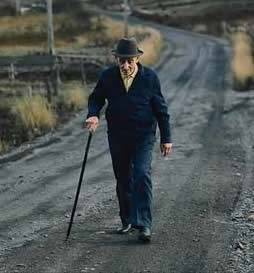|
|
Another Other America?
By Harold Meyerson, The American Prospect
January 6, 2005

Once upon a time, in a land that stretched from one great sea to another, half the elderly were poor. When their work life was done, they retreated into their rented room or their trailer, or their room at their children's home, or even the county poorhouse. Their rulers looked at their plight and concluded that, "at least one-half of the aged -- approximately eight million people -- cannot afford today decent housing, proper nutrition, adequate medical care . . . or necessary recreation."
And the name of this nation, and the unimaginably distant time when half the elderly lived this way? The United States of America in the year 1960.
We have come so far in such a short time that's it's hard for people who aren't seniors to imagine an America in which old age was all but synonymous with desperation. In 2003 just 10.2 percent of Americans aged 65 or older lived in poverty -- a figure two points lower than the national poverty rate of 12.4 percent. Once the age group with the highest rate of poverty, seniors have become the age group with the lowest rate.
There's no great mystery to unravel here. Above all, what changed the lives of America's senior citizens were the significant increases in Social Security benefits enacted in the 1960s and '70s, and the indexing of those benefits to average wage growth. But since the Bush administration is reportedly soon to propose ending that indexing, and replacing it with a different formula that would greatly reduce benefits, it's worth taking a moment to look back at senior poverty as it existed in the year of John F. Kennedy's election as president.
In 1960, when the Senate Subcommittee on the Problems of the Aged and Aging issued its report -- which is the source of the quotation in the first paragraph -- poverty among the elderly was pervasive. Two years earlier the Census Bureau had concluded that almost 60 percent of seniors had annual incomes under $1,000 a year, at a time when the government estimated an adequate yearly budget for a retired couple to be roughly $3,000. Family members and friends helped support seniors, of course, but the 1961 White House Conference on Aging concluded that that assistance amounted to just 10 percent of seniors' incomes -- and less than that, of course, among poorer families. The elderly received their Social Security checks, too, but they still amounted to chump change. In 1959 the average monthly check came to just $70.
I've culled these mournful numbers from Michael Harrington's 1962 classic exposť of destitution amid affluence, The Other America, a book that dared to propose that the nation could eliminate the poverty in its midst. The Other America was one factor that led Kennedy and Lyndon Johnson to initiate a war on poverty -- a major component of which was a war on senior poverty that included the establishment of Medicare and a vast expansion of Social Security. Forty years later the war on senior poverty stands as a stunning success.
Today, however, the United States is governed by a president who is affronted by the very idea of a successful government program. According to a story in yesterday's Post, President Bush wants to change the Social Security indexing formula in a way that will reduce monthly payments by 32.5 percent by 2052 and 45.9 percent by 2075. Today a retiree receives a Social Security check that equals 42 percent of the average worker's wage; if Bush's plan is enacted, that check will shrink to just 20 percent of that wage.
Having tossed America's future seniors 100 feet overboard, the administration then proposes to toss them a 50-foot rope: They can invest a portion of their incomes in the stock market. Problem is, as a retirement system, the stock market offers nothing close to the security that Social Security offers. The lower a worker's income, moreover, the less he has to invest and the smaller his return will be. Social Security, by contrast, deliberately distributes its benefits to provide extra income to those recipients whose earnings were low.
Worse yet, the shift from Social Security to the stock market parallels a shift in employer- provided retirement plans. In 1980, 39 percent of American workers had defined-benefit pension plans; today just 21 percent do, as employers have shunted their employees into 401(k) investment plans. If Bush gets his way, both the government's retirement plan and employers' will be supplanted by plans based on stock performance. If Bush gets his way, his chief domestic achievement will be to have turned "secure retirement" into an oxymoron. And to have taken some sizable number of our seniors and plunged them back into an almost forgotten Other America.
Harold Meyerson is the Prospect's editor-at-large. This column originally appeared in The Washington Post.
|
|



